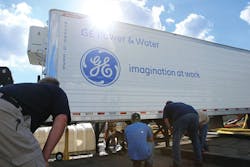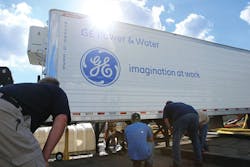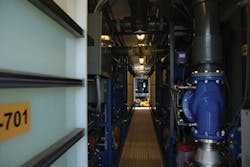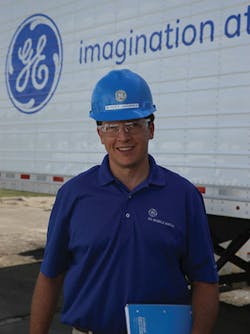Mobile Water Units Help Recovery Efforts in Lumberton, N.C.
By Scott Whittaker
After leaving a trail of destruction in Haiti, Hurricane Matthew methodically made its way toward the southeastern coastline of the United States. As it arrived just off the coasts of Florida, Georgia, South Carolina and North Carolina, on October 8, 2016, the National Weather Service classified Matthew as a Category 1 hurricane with winds reaching 75 miles per hour.
While Matthew battered many towns along the southeastern coastal region, it left a lasting mark on one town in particular - the city of Lumberton, N.C. With torrential rain and high winds, Matthew swelled water levels in the Lumber River, causing the levee that parallels Interstate 95 to overflow. This caused massive amounts of flooding, leaving the town’s water treatment facility under four feet of water and causing outages of the power grid and backup power systems. The residents of Lumberton had not experienced such levels of flooding since Hurricane Floyd in 1999.
The flooding left equipment used to sanitizedrinking water and extract sediment damaged and inoperable. The floods completely shut down the City of Lumberton Water Treatment Plant - the town’s sole water treatment facility - increasing the risk of elevated pathogens and other contaminants in the water supply, effectively leaving the population with no fresh water.
With flood waters engulfing the plant, City Manager Wayne Horne publicly stated that there was no way to determine the amount of time it would take to restore the water plant and get fresh water flowing again.
Days later, as the flood waters began to recede, federal, state and local officials began damage assessments. Officials were then able to estimate that it would be at least several weeks before the town could have fresh water. State water experts expressed concern that the town’s water supply may have been breached by bacteriological contamination. Without testing to confirm contamination, officials warned residents to boil their tap water before using.
The town of Lumberton faced a serious crisis. With the water treatment plant off line, the more than 20,000 residents would be in dire need of safe drinking water. Given the mandate to get fresh water into the homes of the residents, North Carolina Emergency Management (NCEM) Area Coordinator Eric Wiseman arrived at the Lumberton Water Treatment Plant with one goal: get the plant back on line.
“When I arrived, here was a plant that had gone from making about 7 million gallons of water a day to making zero. Nothing was coming out of it whatsoever,” Wiseman said. “This was serious [getting the plant back on line] for the people, serious for the health of the community and serious for the economic impact of the community to get something flowing through the water lines to the town.”
Wiseman faced multiple challenges in his efforts to get the water flowing again. The plant had been under four feet of water for several days, leaving essential water treatment and electrical equipment in ruins. The county power grid and on-site backup generator also were destroyed. Getting mobile generators would be easy enough, but how could he possibly get the equipment needed to treat enough water for more than 20,000 people in a very short amount of time?
“We typically use military resources for temporary water disruptions. Historically, they make very good water production albeit in very low volume,” Wiseman said. “They treat about 10 to 12 thousand gallons daily, but Lumberton needed about 4 to 5 million gallons per day.”
“When one of our guys said ‘we’ve got this [GE] resource,’ I told them to check it out,” he said. Wiseman wanted to discuss details about how GE could help the emergency management team get fresh water flowing as soon as possible. Within hours, he met with GE Water’s Lee Page Dupree to better understand GE’s capabilities. “Once we got the particulars, we had a very quick turnaround. I don’t remember exactly, but I’d say within 24 hours we had one of the [GE] vehicles sitting here.”
After sending a request to NCEM headquarters to find resources to make approximately 5 million gallons of water per day, Wiseman quickly received word back that GE’s Water & Process Technologies could meet the production requirements. To do that, GE recommended that NCEM use its ultrafiltration mobile water units. The mobile units utilize GE’s ultrafiltration membrane technology to produce superior water quality from contaminated (or potentially contaminated) water at treatment rates of up to 2,000 gallons per minute. Within 48 hours from the time NCEM began its search for a solution, the mobile units had produced 2.4 million of the 5 million gallons of fresh water needed for Lumberton residents.
“We received the call from [NCEM] about a quick response need for water late on a Friday. We had GE staff on site the next day,” explained Scott Gorry, regional manager for GE’s Water & Process Technologies. “We mobilized two GE ultrafiltration water units and had them both on site producing 2.4 million gallons of fresh water that Sunday. Subsequently, we had an additional two units on location and being prepped for hook up to untreated water sources by that Monday.”
Because Water & Process Technologies operates such a large mobile water treatment fleet, they were able to quickly provide the city of Lumberton a customized solution that met the city’s emergency water requirements for pretreatment, post-treatment and total water production. The mobile water units provided the needed extra treated water capacity. The treated water solutions ramped up from 2,000 gpm to over 4,600 gpm (454 m3/h to 1,045 m3/h) saving the city both time and money.
With the mobile water units delivering the needed 5 million gallons per day, the city of Lumberton had moved closer to a sense of normalcy. “Even though we had the challenge of having never worked with GE before, once we learned where the hoses run, how they hooked up, electrical connections and where landing gear had to sit, the units were up and running,” Wiseman said. “With the people getting the water they needed, we could make more progress on getting the plant back in operation.”
“Our mobile water systems provide guaranteed water quality and quantity. Complying with environmental regulations and handling various influent waters, our fleet of trailer-based systems can be deployed in an emergency like in Lumberton or on longer-term bases depending on the need,” said Gorry. “Our mobile water units filled the need until the Lumberton Water Treatment Plant could be put back on line.”
About the Author: Scott Whittaker is the North American Sales Manager for the Build, Own, And Operate (BOO), Mobile Water, and Service Deionization (SDI) group for GE Water & Process Technologies, based in Bedford, N.H.




